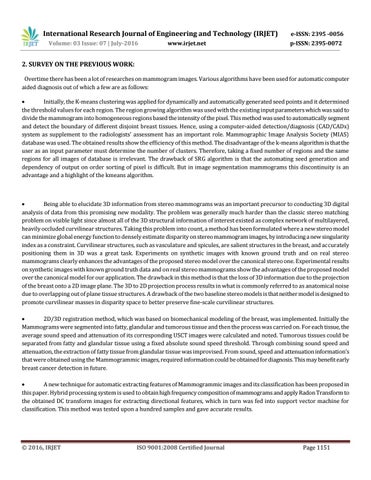International Research Journal of Engineering and Technology (IRJET) Volume: 03 Issue: 07 | July-2016
www.irjet.net
e-ISSN: 2395 -0056 p-ISSN: 2395-0072
2. SURVEY ON THE PREVIOUS WORK: Overtime there has been a lot of researches on mammogram images. Various algorithms have been used for automatic computer aided diagnosis out of which a few are as follows: Initially, the K-means clustering was applied for dynamically and automatically generated seed points and it determined the threshold values for each region. The region growing algorithm was used with the existing input parameters which was said to divide the mammogram into homogeneous regions based the intensity of the pixel. This method was used to automatically segment and detect the boundary of different disjoint breast tissues. Hence, using a computer-aided detection/diagnosis (CAD/CADx) system as supplement to the radiologists’ assessment has an important role. Mammographic Image Analysis Society (MIAS) database was used. The obtained results show the efficiency of this method. The disadvantage of the k-means algorithm is that the user as an input parameter must determine the number of clusters. Therefore, taking a fixed number of regions and the same regions for all images of database is irrelevant. The drawback of SRG algorithm is that the automating seed generation and dependency of output on order sorting of pixel is difficult. But in image segmentation mammograms this discontinuity is an advantage and a highlight of the kmeans algorithm.
Being able to elucidate 3D information from stereo mammograms was an important precursor to conducting 3D digital analysis of data from this promising new modality. The problem was generally much harder than the classic stereo matching problem on visible light since almost all of the 3D structural information of interest existed as complex network of multilayered, heavily occluded curvilinear structures. Taking this problem into count, a method has been formulated where a new stereo model can minimize global energy function to densely estimate disparity on stereo mammogram images, by introducing a new singularity index as a constraint. Curvilinear structures, such as vasculature and spicules, are salient structures in the breast, and accurately positioning them in 3D was a great task. Experiments on synthetic images with known ground truth and on real stereo mammograms clearly enhances the advantages of the proposed stereo model over the canonical stereo one. Experimental results on synthetic images with known ground truth data and on real stereo mammograms show the advantages of the proposed model over the canonical model for our application. The drawback in this method is that the loss of 3D information due to the projection of the breast onto a 2D image plane. The 3D to 2D projection process results in what is commonly referred to as anatomical noise due to overlapping out of plane tissue structures. A drawback of the two baseline stereo models is that neither model is designed to promote curvilinear masses in disparity space to better preserve fine-scale curvilinear structures. 2D/3D registration method, which was based on biomechanical modeling of the breast, was implemented. Initially the Mammograms were segmented into fatty, glandular and tumorous tissue and then the process was carried on. For each tissue, the average sound speed and attenuation of its corresponding USCT images were calculated and noted. Tumorous tissues could be separated from fatty and glandular tissue using a fixed absolute sound speed threshold. Through combining sound speed and attenuation, the extraction of fatty tissue from glandular tissue was improvised. From sound, speed and attenuation information’s that were obtained using the Mammogrammic images, required information could be obtained for diagnosis. This may benefit early breast cancer detection in future. A new technique for automatic extracting features of Mammogrammic images and its classification has been proposed in this paper. Hybrid processing system is used to obtain high frequency composition of mammograms and apply Radon Transform to the obtained DC transform images for extracting directional features, which in turn was fed into support vector machine for classification. This method was tested upon a hundred samples and gave accurate results.
© 2016, IRJET
ISO 9001:2008 Certified Journal
Page 1151
